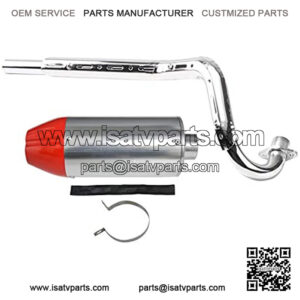1. Cat back exhaust
Cat-back exhaust systems are modifications to the exhaust pipe that improve airflow. Larger exhaust pipe means less backpressure and more power.
The system runs from the tip of the exhaust to the catalytic part of the system and is comprised of one pipe connecting a muffler and a catalytic converter, as well as an end for directing emissions out through.
A cat back exhaust system is a simple power modification that will free up your car’s exhaust gas flow and produce a more pronounced engine sound than the stock muffler.
A more restrictive catalytic converter will limit the amount of power gained from a cat back exhaust system.
A cat back exhaust might not seem like the most important upgrade to your car but adding one can increase horsepower.
Aftermarket exhaust systems are designed to be more open than your stock exhaust, interrupting less of the engine’s airflow.
These changes can result in reduced back pressure at the engine manifold, meaning that the engine can breathe easier and produce more power.
A cat back exhaust system can offer a significant increase in horsepower when the stock exhaust restricts too much airflow.
Opening up airflow changes the power band of your car, resulting in an increase in horsepower.
In this case, you might observe horsepower gains of more than 10 HP.
Cat-back exhaust systems for a car range from $300 to $1200. Factors such as the quality of steel and mufflers will affect the final cost.
Installing a cat-back exhaust system costs between $75 and $100. Local retailers may offer to install it for free if you buy the exhaust from them.
In all 50 US states, cat back systems are legal. However, you should check your local laws before buying one.
2. Downpipe
A downpipe is a tube that directs exhaust gases from the turbo into the exhaust system. The less restrictive it is, the harder exhaust gases can flow and spool the turbo.
NOTE: A downpipe only works with turbo cars. So make sure your car has turbo before considering an aftermarket turbo.
Installing a downpipe is an excellent option for drivers who want to maximize their car’s power at every RPM.
While installing one will create a noticeable increase in the turbo’s output, even if it’s just 40-50 horsepower, there are still more benefits of a downpipe.
A downpipe will cost you around $350 and installation cost will be around $200. Installing it yourself is also an option. Though, it could get a bit difficult because there’s not much space to work with.
Therefore, it is recommended to ask a mechanic to install it.
Aftermarket downpipes are not street-legal because they have less restrictive catalytic converters – which can increase emissions (but great for horsepower).
Ensure that you ask specifically for the state in which your vehicle is registered. Some states prohibit certain modifications to a car even if it was obtained elsewhere, while others have no problem granting such requests.
3. Headers
An exhaust header is a pipe that connects to the engine’s exhaust manifold and runs to one or more mufflers.
The purpose of this system is to reduce back pressure, which increases power output for the engine.
Exhaust headers are designed to collect exhaust gases that come out of the engine and merge them into a single flow. They are made of thin stainless steel and have equal length – this allows for optimal efficiency with exhaust gases.
An Exhaust Header adds about 15-20 horsepower to your car’s engine.
Exhaust Header improves HP by helping the engine evacuate the exhaust fumes that it has to push out.
It will cost you around $700. The process of installing an exhaust header is really difficult. I would recommend you ask a mechanic to install it for you.
Headers aren’t always illegal, some vehicles come stock with them, and most short tube headers are considered legal in most states.
Long tube headers on the other hand are a bit of a different story. Not only will they make your vehicle louder, but it is also considered tampering with your vehicle’s emissions, which according to the EPA is illegal under federal law.
4. Turbo (or bigger turbo)
Adding a turbo to a car’s engine is a highly effective way of massively increasing its power.
In simple terms, a turbo forces more air into the engine’s cylinders which, added to some extra fuel, means a bigger bang can be created in the cylinder.
A bigger bang means more power.
An internal combustion engine works by drawing in fuel and air. That mixture is ignited to produce power, but the exhaust gases are also produced and are forced out of the system. In turbocharged engines, the exhaust gas is reused.
A turbocharger works with the exhaust system. Ultimately, it forces air into your car’s engine which facilitates an increase in power.
Depending on the specific model, a turbocharger could give you 70-150 pounds additional horsepower.
The cost of the turbocharger will depend on make and model but can start at around $400 with labor costing an additional $150-$200.
As long as your car passes your state’s emissions check and physical safety inspection, you’ll be allowed to equip it with a turbocharger.
Therefore, you should check your state laws before buying a turbocharger.
About atv exhaust
“atv exhaust silencer”
“atv exhaust brands”
“atv exhaust wrap”
“loudest atv exhaust”

